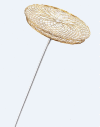A multi-center trial on efficacy and safety of the LifeTech CeraFlexTM ASD occluder for transcatheter closure in patients with secundum atrial septal defects
- PMID: 36033225
- PMCID: PMC9412214
- DOI: 10.21037/cdt-21-798
A multi-center trial on efficacy and safety of the LifeTech CeraFlexTM ASD occluder for transcatheter closure in patients with secundum atrial septal defects
Abstract
Background: The last decades have brought remarkable improvements in treatment strategy and occluder modification of secundum atrial septal defect (ASD) closure. Approval, efficacy and safety of ASD closure devices have previously been demonstrated. This study investigated the clinical efficacy and safety of the LifeTech CeraFlexTM ASD occluder for interventional closure of secundum ASD with a 6-month follow-up (FU).
Methods: Procedure specific data was collected on patients considered for ASD closure with the CeraFlexTM occluder between April 2016 and December 2019 in three German centers. Efficacy and safety were assessed after device closure, at discharge, and at 6-month FU.
Results: The primary endpoint (successful ASD closure without severe complications) was reached by 102/103 patients (99%). Device embolization occurred in two patients (one early and one late embolization). After early snare-retrieval of an embolized device, this ASD was closed surgically and in the other patient with late device embolization the defect was closed with a larger CeraFlexTM occluder. The secondary endpoint (clincal efficacy after 6 months) was reached by 94/98 patients since new onset of arrhythmia occurred in four patients. Three patients had withdrawn their study-participation and one patient had moderate residual shunt, but not related to the occluder. Incomplete right bundle branch block (iRBBB) was seen in 31 patients. At last FU only 17 patients had remaining iRBBB documenting effective volume unloading of the right ventricle.
Conclusions: Catheter interventional closure of secundum ASDs with the CeraFlexTM ASD occluder was feasible, safe and effective in this study.
Keywords: CeraFlexTM; Interventional closure; secundum atrial septal defect (secundum ASD); septal occluder.
2022 Cardiovascular Diagnosis and Therapy. All rights reserved.
Conflict of interest statement
Conflicts of Interest: All authors have completed the ICMJE uniform disclosure form (available at https://cdt.amegroups.com/article/view/10.21037/cdt-21-798/coif). The series “Current Management Aspects in Adult Congenital Heart Disease (ACHD): Part V” was commissioned by the editorial office without any funding or sponsorship. A Engelhardt and DT report grants from Medtronic and LifeTech. ID reports that he was paid by the German Heart Center a reimbursement. A Eicken reports that he has acted as proctor for LifeTech ASD-Occlusion. The authors have no other conflicts of interest to declare.
Figures
References
-
- Fuster V, Brandenburg RO, McGoon DC, et al. Clinical approach and management of congenital heart disease in the adolescent and adult. Cardiovasc Clin 1980;10:161-97. - PubMed
-
- Warnes CA, Williams RG, Bashore TM, et al. ACC/AHA 2008 guidelines for the management of adults with congenital heart disease: a report of the American College of Cardiology/American Heart Association Task Force on Practice Guidelines (Writing Committee to Develop Guidelines on the Management of Adults With Congenital Heart Disease). Developed in Collaboration With the American Society of Echocardiography, Heart Rhythm Society, International Society for Adult Congenital Heart Disease, Society for Cardiovascular Angiography and Interventions, and Society of Thoracic Surgeons. J Am Coll Cardiol 2008;52:e143-263. 10.1016/j.jacc.2008.10.001 - DOI - PubMed
LinkOut - more resources
Full Text Sources
Miscellaneous


